UNIT 1 - sensation
1/106
There's no tags or description
Looks like no tags are added yet.
Name | Mastery | Learn | Test | Matching | Spaced |
|---|
No study sessions yet.
107 Terms
What is sensation?
When our sensory receptors and nervous system receives sensory input from the environment.
Ex: Our thermoreceptors sense that the temperature has dropped.
What is perception?
The process or organizing & interpreting sensory information to give it meaning. (Connecting them to thoughts & emotions)
Ex: Your brain perceives that it is cold, so you put on a jacket to stay warm.
Vision: Sensing
You notice a bright light in the room.
Vision: Perceiving
You understand that the light indicates that someone has entered the room, & think about how it makes you feel more alert.
Audition: Sensing
You hear music playing in the background.
Audition: Perceiving
You recognize the song & recall memories associated w/ it, thinking about why it makes you feel that way.
Gustation: Sensing
You taste a sweet piece of chocolate.
Gustation: Perceiving
You reflect on how the chocolate reminds you of celebrations & joy, & you think about whether you want more based on that memory.
Touch: Sensing
You feel a soft blanket against your skin.
Touch: Perceiving
You associate the softness w/ comfort & your home, thinking about how it makes you feel safe & cozy.
Temperature: Sensing
You notice that the water in the pool is cold.
Temperature: Perceiving
You remember an uncomfortable time when you jumped into cold water & think about whether you want to dive in or wait until it warms up.
Pain: Sensing
You feel a sharp pain in your foot.
Pain: Perceiving
You think about how the pain might have occurred, whether it’s by an injury or if your shoe is too tight, & how it affects your ability to walk.
What is bottom-up processing?
Starting w/ the sensory input, the brain tries to understand.
Ex: You see a long, slim, slithering creature on the ground… you process… ah! A snake!
What is top-down processing?
Guided by experience & higher-level processes, we see what we expect to see.
Ex: An experienced hiker expects to see snakes on their hike so lizards, sticks, etc. all seem like snakes.
What is selective attention?
Our tendency to focus on just a particular stimulus among the many that are being received.
Although we are surrounded by many senses, we tend to pay attention to only a few at a time.
Example of selective attention
The cocktail party effect - the ability to focus on a particular sound while filtering out other sounds
You’re at a crowded party & everyone is loud. You’re focusing your attention on the conversation with your friend nearby. Then someone on the other side of the room says your name and you hear it.
This is called the cocktail party effect — you focused your attention on one particular voice amidst the crazy loudness of all those other voices.
Example #2 of selective attention
28% of traffic accidents occur when drivers are chatting on cell phones or texting. Using a phone while driving is distracting your attention & leads to the risk of a car accident.
What is selective inattention?
At the level of conscious awareness, we’re in only one place at a time & so we miss salient objects (objects that stand out) that are available to be sensed.
What is inattentional blindness?
When you fail to see visible objects when our attention or focus is directed elsewhere.
What is change blindness?
When you fail to notice changes in the visual environment.
What are the 3 steps involved in sensation & what is transduction?
The conversion of one form of energy, like light waves, into another form, like neural impulses that our brain can interpret.
Step 1: Receive
Step 2: Transform
Step 3: Deliver
What is psychophysics?
The study of relationships between the physical characteristics of stimuli, like their intensity, & our psychological experience of them.
Ex. What is it about the smell, taste, & texture of buttery popcorn that produces a happy, delicious, & satisfied response in you?
What is absolute threshold?
The minimum stimulation needed to detect a particular stimulus 50% of the time.
What is difference threshold?
The minimum difference between 2 stimuli required for detection 50% of the time. Also known as the JND - Just noticeable difference
How do we test for absolute threshold in a sense like audition?
A hearing specialist exposes both of your ears to varying sound levels. For each tone the test defines the pitch at which you can detect the tone 50% of the time.
What is the signal detection theory?
A theory predicting how & when we detect the presence of a faint stimulus amid background stimulation.
Depends on 2 conditions:
the strength of the signal (how loud the sound is, how bright the light, how heavy the touch…)
& our psychological state (our experience, our expectations, our motivation, & how alert we are)
What is Weber’s Law?
To be able to tell the difference between degrees of stimulation, 2 stimuli must differ by a constant minimum %.
How does Weber’s law help explain the JND? (Just noticeable difference)
The difference threshold is the minimum difference between 2 stimuli required for detection 50% of the time.
We experience the difference threshold as a JND (Just noticeable difference).
Weber’s Law tells us that the difference must vary by a constant PERCENTAGE, not a constant amount.
What are subliminal stimuli & how are we affected by them?
Subliminal stimuli are not detectable 50% of the time. They are below your absolute threshold.
You may not notice subliminal stimuli at all if they are weak.
Studies show subliminal stimuli can influence thoughts. It helps researchers explore how the brain processes info without conscious awareness.
What is priming?
Priming is the activation, often unconsciously, of certain associations, thus predisposing one’s perception, memory, or response.
Even if YOU don’t think YOU notice a stimuli, your brain might, & that can impact you.
Priming shows how exposure to certain stimuli can shape thoughts, behaviors, & interpretations in various contexts.
Ex: Seeing advertisements for a specific brand frequently might make a consumer more likely to choose that brand when shopping, even if they initially intended to choose something else.
What is sensory adaptation?
Diminished sensitivity to stimuli as a consequence of constant stimulation.
Evolutionary psychologists suggest that once we notice & evaluate a new stimuli as non-threatening, we pay less attention to it.
This saves our attention for new incoming stimuli, or changes in the existing stimuli. This could be adaptive for survival.
Why does sensory adaptation occur?
Being able to ignore unthreatening/unchanging stimuli leaves us free to focus on stimuli that IS changing.
Our sensory receptors are alert to novelty as a new situation means we need to evaluate & assess it to check for danger, so it is adaptive & functional.
We perceive the world not exactly as it is but as it is useful for us to perceive it.
What light energy is visible to humans?
The part of the spectrum visible to humans is actually quite small.
We can see light waves w/ a frequency of a little less than 400nm & a little more than 700nm.
What are characteristics of light waves?
Frequency (wavelength):
Short wavelength=high frequency (bluish colors),
Long wavelength=low frequency (reddish colors)
Amplitude (height):
Great amplitude (bright colors),
small amplitude (dull colors)
What information do light waves give us?
Wavelength: What hue (or color) am I seeing?
Amplitude: How bright is the color I am seeing?
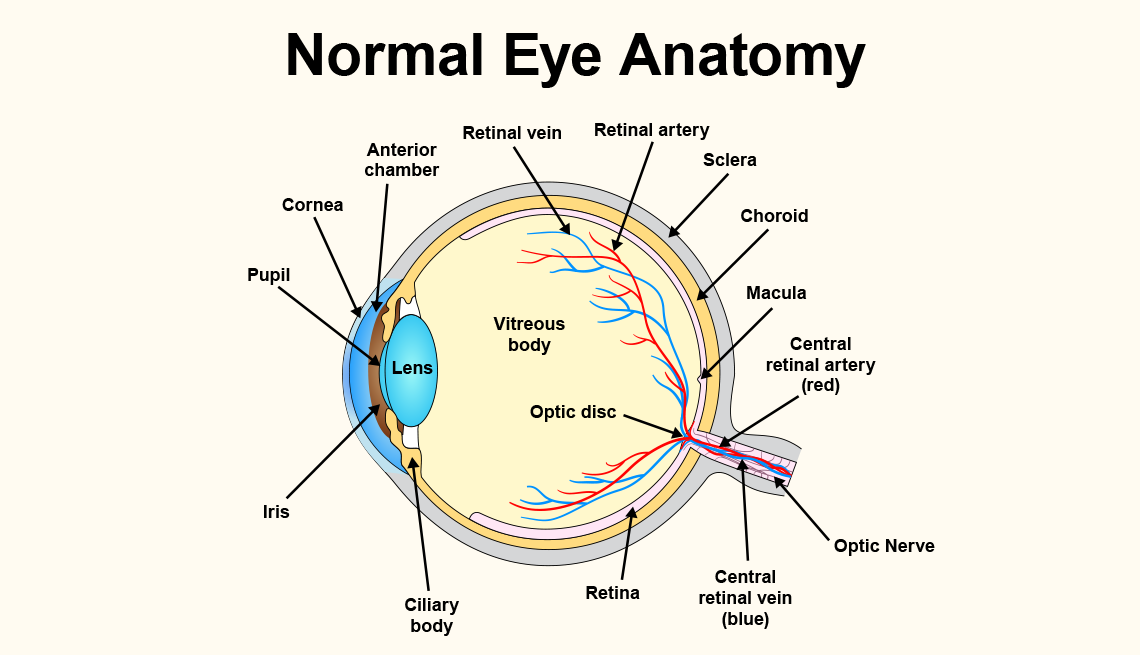
What structure of the eye helps focus the energy?
The cornea & the lens
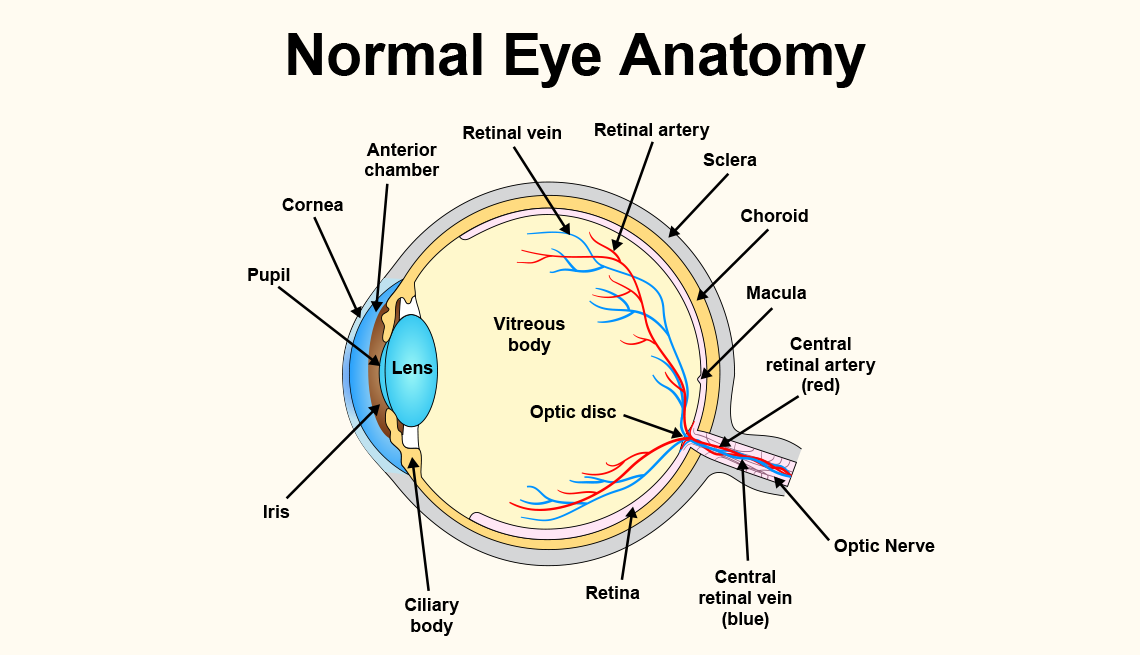
What is the cornea?
The eye’s clear, protective outer layer covering the pupil & iris.
Light enters the eye first through the cornea.
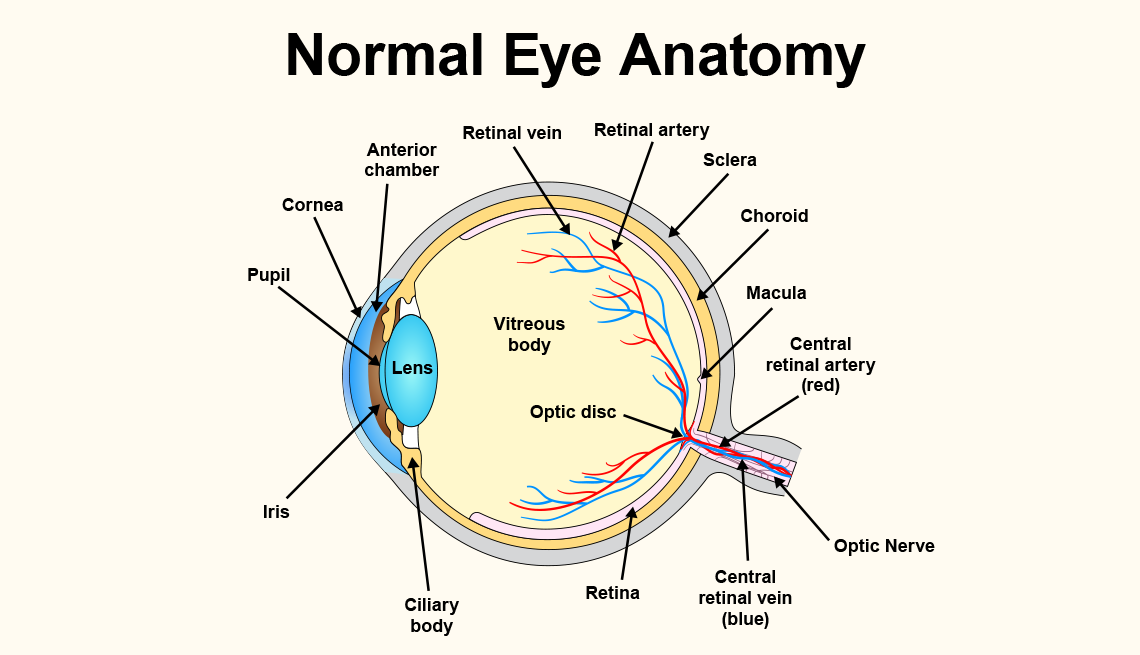
What is the pupil?
A small adjustable opening in the center of the eye through which light passes.
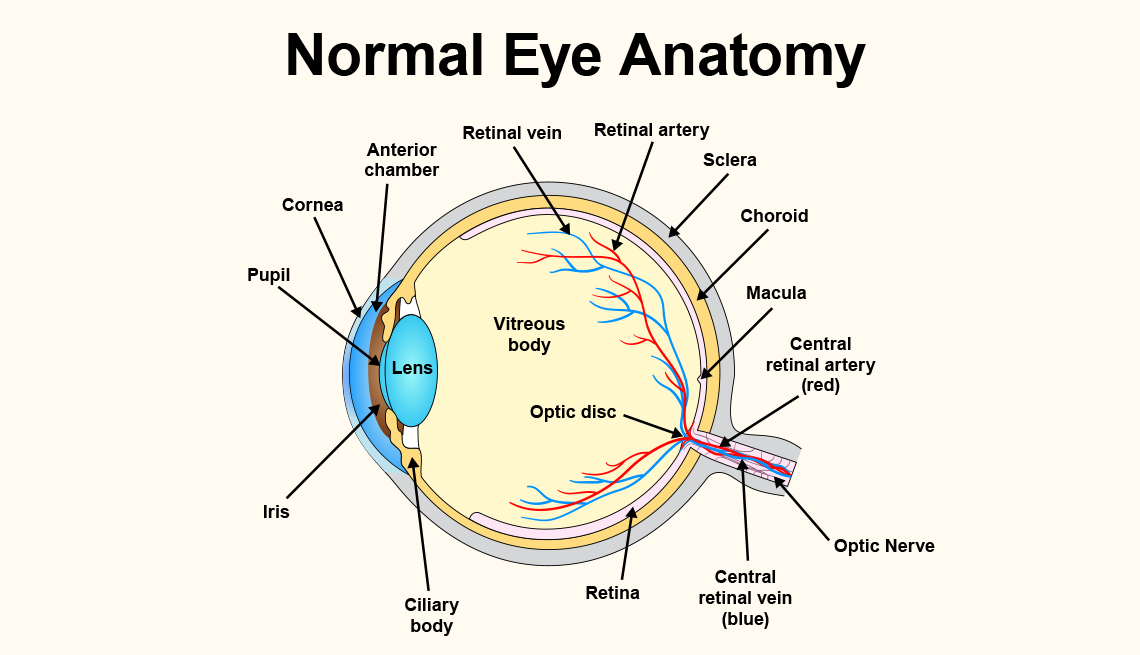
What is the iris?
A ring of muscle tissue that forms the colored portion of the eye around the pupil & controls the size of the pupil opening by expanding & contracting over the pupil.
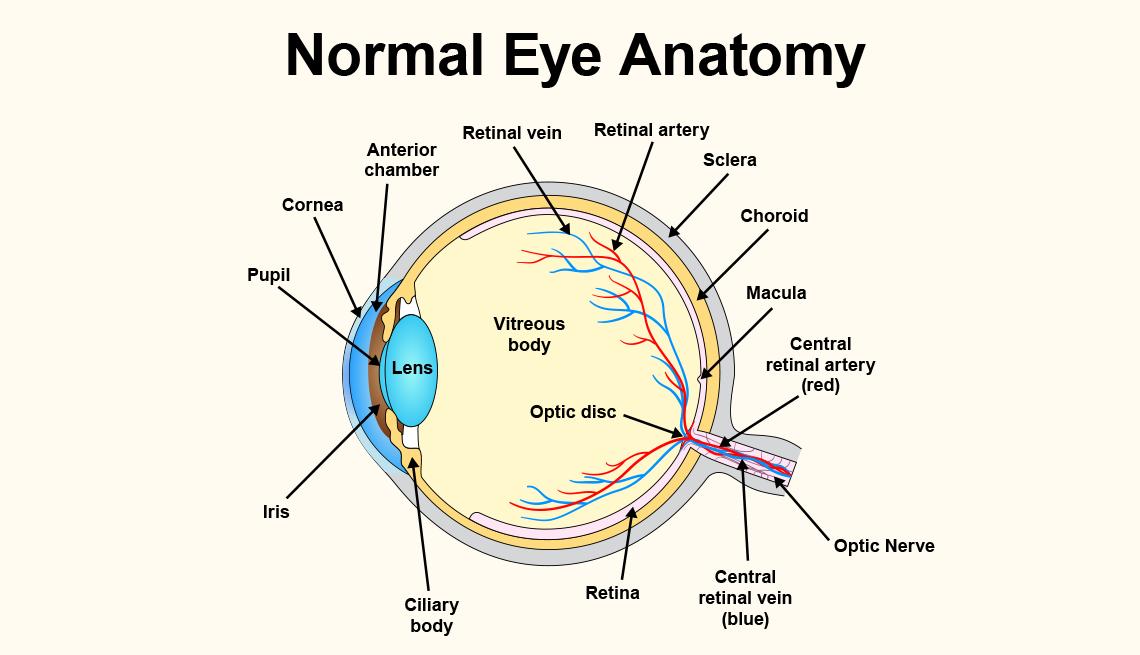
What is the lens?
The transparent structure behind the pupil that changes shape to help focus images on the retina.
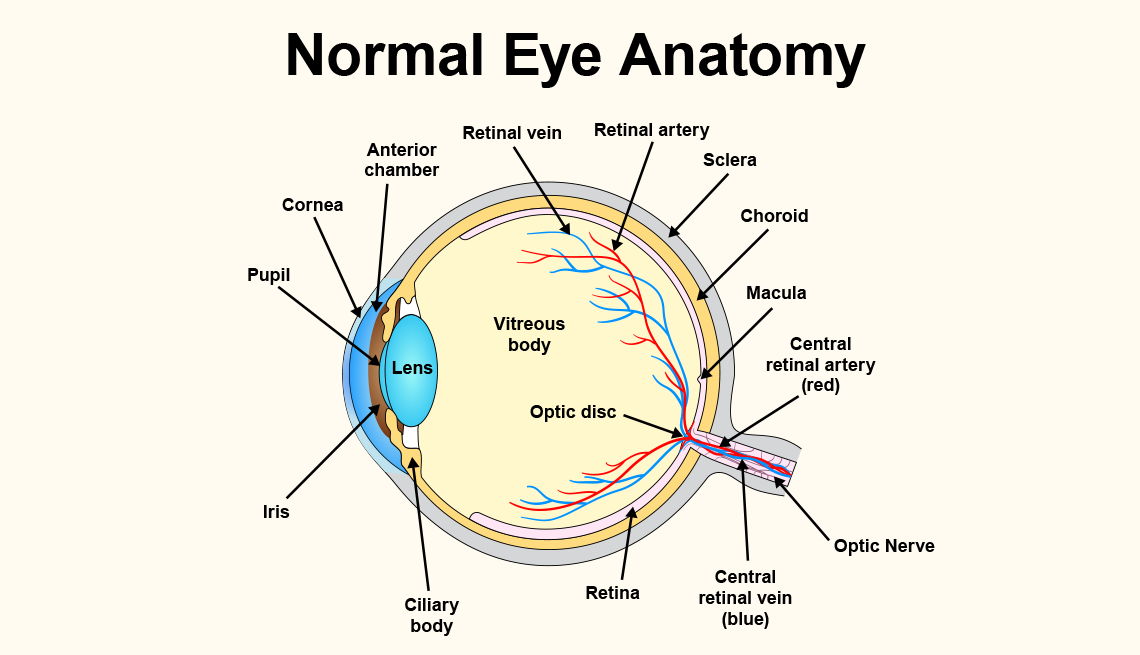
How does the lens change shape?
To focus the rays, the lens changes its curvature & thickness in a process called accomodation.
If the lens focuses the image on a point in front of the retina, you see near objects clearly but not distant objects. This nearsightedness (myopia) can’t be fixed by glasses, contact lenses, or surgery.
Farsightedness (hyperopia) is a result of the lens focusing light past the retina.
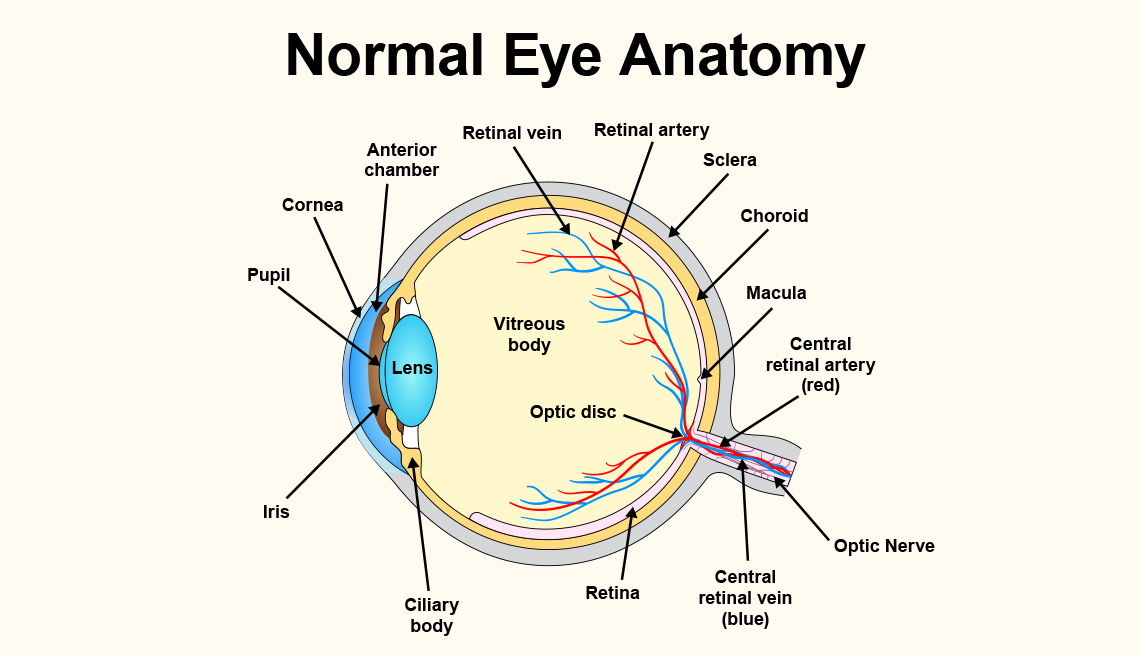
What is the retina?
The light-sensitive inner surface of the eye, containing the receptor rods & cones + layers of neurons that begin the processing of visual info.
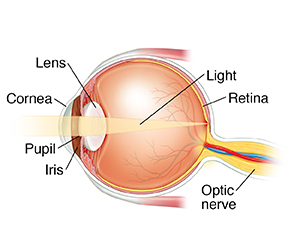
Where is the retina located?
Along the back of the eye & contains the sense receptor cells (rods & cones) that will receive the incoming light waves.
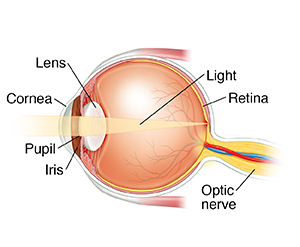
What happens in the retina?
Light waves are transducted into neural impulses by the rods & cones, then passed to the bipolar cells & the ganglion cells.
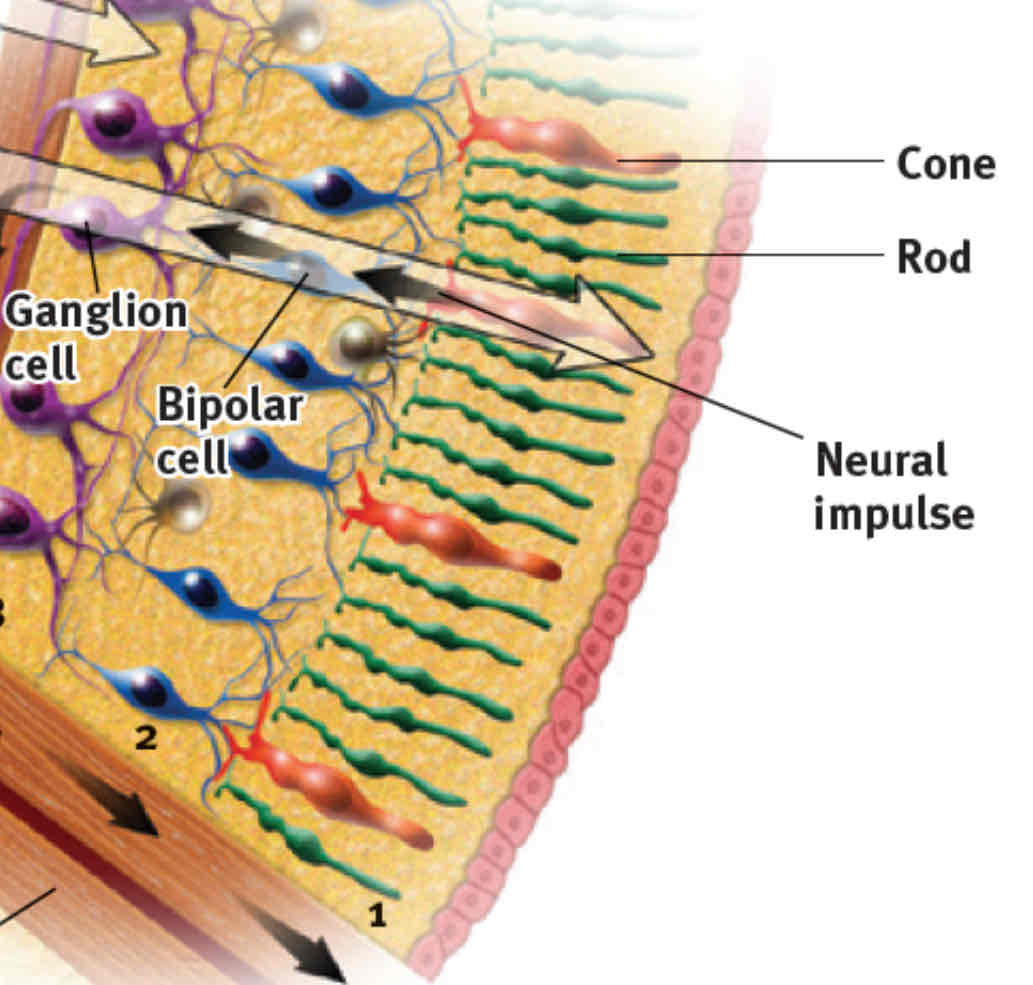
What are rods?
Retinal photoreceptors that detect black, white, gray, & are sensitive to movement.
They are necessary for peripheral & night vision, when cones don’t respond.
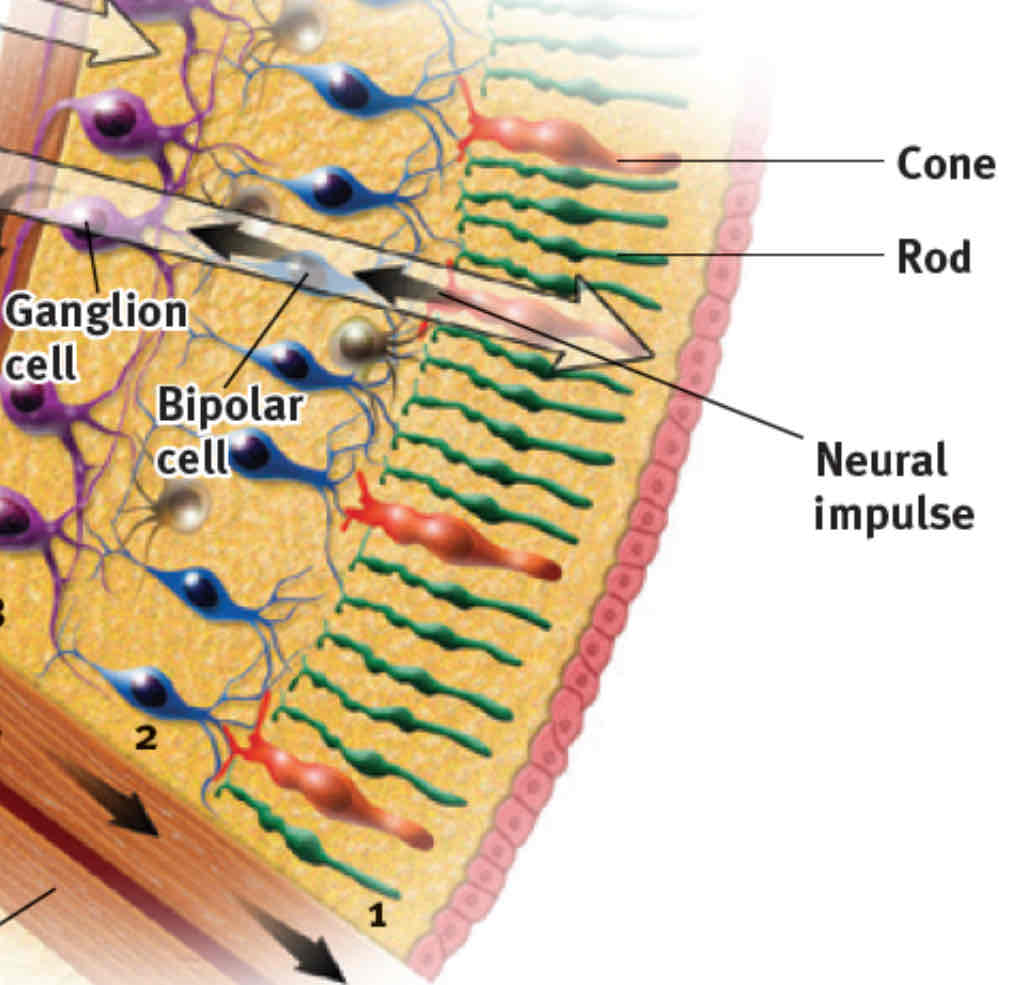
What are some characteristics of rods?
Located along the retina’s outer periphery
Sensitive in dim light, & they enable black-and-white vision.
They have no hotline to the brain, they connect to a single bipolar cell sending a combined message to the brain.
Sensitive to faint light & peripheral motion.
What are cones?
Retinal photoreceptors that are concentrated near the center of the retina & function in daylight or in well-lit conditions.
They detect fine detail & create color sensations.
What are some characteristics of cones?
They cluster in & around of the fovea.
In dim light, they become unresponsive & we are unable to see color.
Many of them have their own hotline to the brain: One cone transmits its message to a single bipolar cell, which relays the message to the visual cortex (where a large area receives input from the fovea).
How do air pressure waves become sound?
Sound is created when objects vibrate, causing air pressure waves to form. These waves travel through the air (or other mediums) & reach our ears.
When these waves hit our eardrums, they cause it to vibrate.
What information do sound waves give us? How do we perceive them?
Short-wavelength= Higher frequency waves —> creates a higher pitch.
Low wavelength= Lower frequency waves —> creates a lower pitch
A wave w/ a larger amplitude will sound louder. A wave w/ a smaller amplitude will sound quieter. Vice versa.
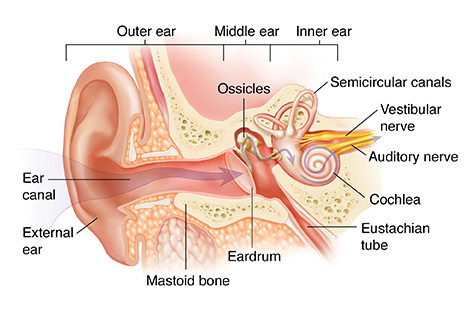
What are the 3 divisions of the ear?
The ear is divided into outer, middle, & inner sections.
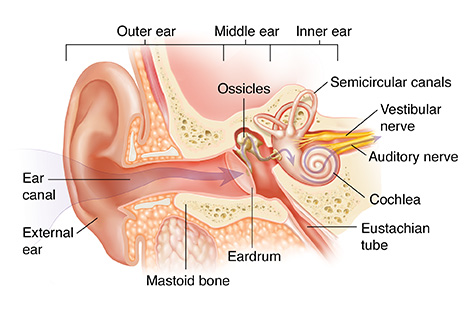
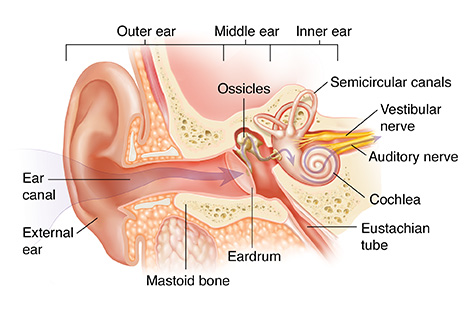
How does the ear transform sound into neural messages?
Passing through accessory structures to sense receptors, vibrating air triggers nerve impulses that the brain decodes as sounds.
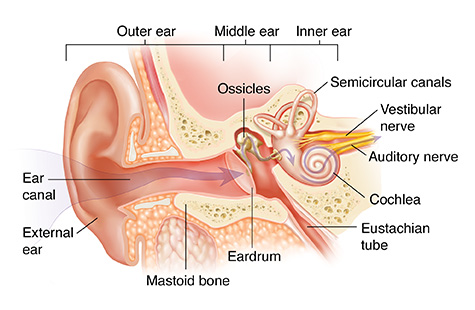
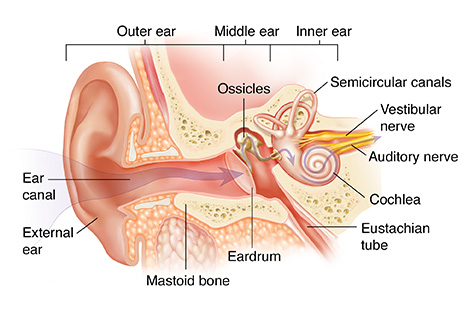
What is the auditory canal?
The channel located in the outer ear that funnels sound waves from the pinna to the tympanic membrane (ear drum)

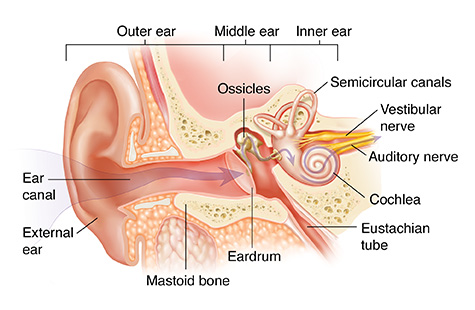
What is the ear drum (tympanic membrane)?
A thin layer of tissue that vibrates in response to sound waves.
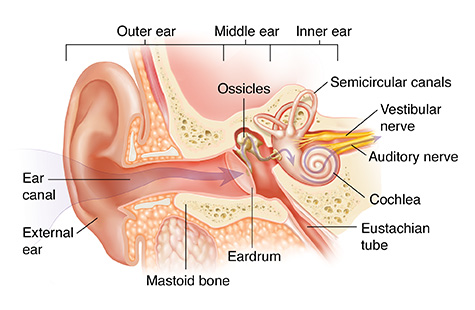
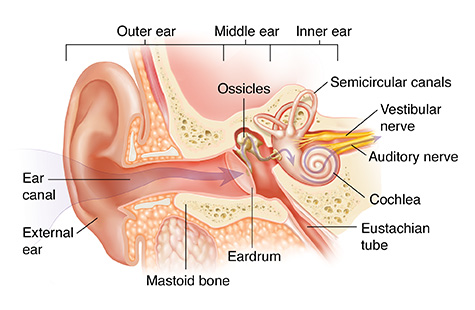
What are the ossicles?
Made up of the 3 smallest bones in the human body, the incus, the malleus, & the stapes, transfer the sound wave vibrations from the tympanic membrane to the oval window of the cochlea.
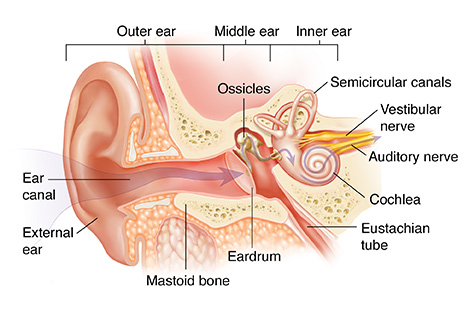
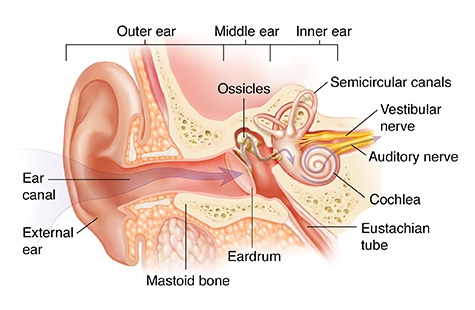
What is the oval window?
The membrane-covered opening of the cochlea. It vibrates when it receives the sound waves & causes the fluid inside the cochlea to move.
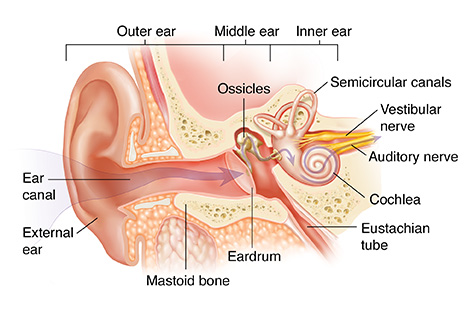
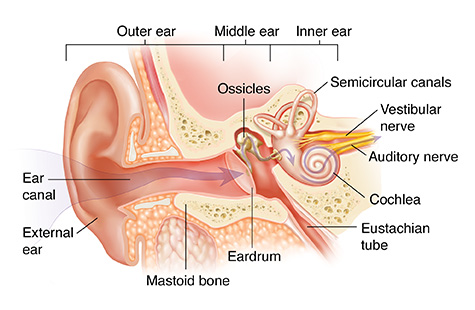
What is the cochlea?
A coiled, bony, fluid-filled tube in the inner ear. Sound waves traveling through the cochlear fluid triggers nerve impulses.
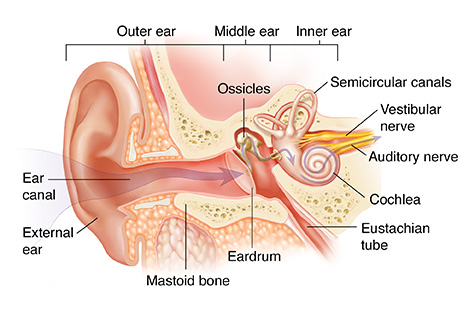
How does the sound wave move through the inner ear?
Accessory structures move the sound wave to the sense receptors (stereocilia) of the basilar membrane in the inner ear where the wave energy undergoes transduction to neural energy that the brain can interpret.

How does transduction occur in the inner ear?
The motion of the sound vibration against the oval window of the cochlea causes ripples in the basilar membrane, bending the hair cells (stereocilia) lining its surface.
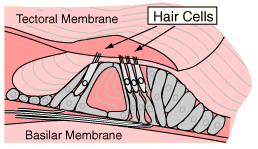
How do impulses trigger in the Auditory Nerve?
The hair cell (cilia) movements trigger action potentials in nearby nerve cells, whose axons converge to form the auditory nerve, sending sound info to the brain.
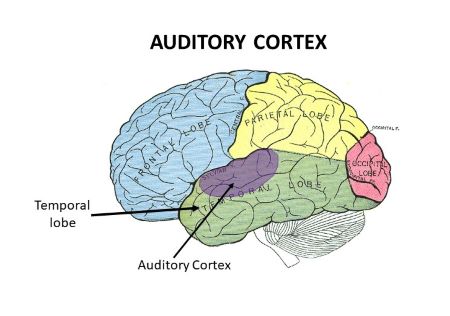
how does the message carry to the brain?
the auditory nerve carries the neural messages to the thalamus & then to the auditory cortex in your brain’s temporal lobes.
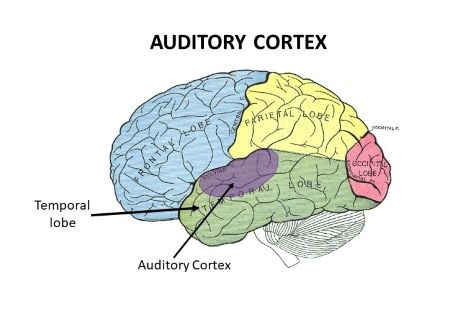
What are the 2 types of hearing loss?
Sensorineural: Damage to the cochlea’s hair cell receptors or the auditory nerve can cause sensorineural hearing loss. With auditory nerve damage, people may hear sound but have trouble perceiving what someone’s saying.
Conduction: Damage to the mechanical system— the eardrum & middle ear bones— that conducts sound waves to the cochlea can cause conduction hearing loss. It is less common than sensorineural hearing loss.
How much sound is too much sound?
As a general rule, any noise we cannot talk over (loud machinery, fans screaming at a sports event, music blasting at maximum volume) may be harmful, especially if prolonged & repeated.
What’s the problem w/ headphones?
Headphones direct all the sound waves into the auditory canal & bombard the basilar membrane. In the open air, sound waves disperse & are not all directed to one location.
How can headphones help?
Putting on ear muffs can help protect the vulnerable hair cells of a child during a loud event.
What is the research on hearing loss?
Since the early 1990s, teen hearing loss has risen by a third & now affects 1 in 5 teens.
Teen boys more than teen girls or adults blast themselves w/ loud volumes for long periods.
What is a cochlear implant?
A device for converting sounds into electrical signals & stimulating the auditory nerve through electrodes threaded into the cochlea
Designed to produce useful hearing sensations (improve hearing) to a person w/ severe hearing loss
How does a cochlear implant work?
Cochlear implants work by translating sounds into electrical signals that are transmitted to the cochlea & relayed to the brain via the auditory nerve.
How does the brain detect loudness?
A soft tone activates only the few hair cells attuned to its frequency.
Given louder sounds, neighboring hair cells also respond.
Thus, the brain interprets loudness from the number of activated hair cells.
Theory #1 of how the brain detects pitch
Place Theory: Says that we hear different pitches due to different sound waves triggering activity at different spots along the cochlea’s basilar membrane.
So, the brain determines a sound’s pitch by recognizing the specific area (on the membrane) that’s generating the neural signal.
Higher frequencies activate hair cells closer to the base, while lower frequencies activate those at the tip.
Theory #2 of how the brain detects pitch
Frequency theory: Says the brain reads pitch by monitoring the frequency of neural impulses traveling up the auditory nerve.
The whole basilar membrane vibrates w/ the incoming sound wave, triggering neural impulses to the brain at the same rate as the sound wave.
If the sound wave has a frequency of 100 waves per second, then 100 pulses per second travel up the auditory nerve.
How does the volley principle explain hearing higher frequency sounds?
By firing in rapid succession, neurons can achieve a combined frequency above 1000 waves per second.
Like soldiers who alternate firing so that some can shoot while others reload, achieving greater combined fire power, neural cells can alternate firing.
This allows use to perceive sounds w/ frequencies that are too high for a single neuron to handle on its own.
How do the 2 theories work together to explain how we hear pitch?
The place theory is good for explaining how we sense high pitches.
The frequency theory is good for explaining how we sense low pitches.
The volley principle helps us understand how our auditory system processes different pitches by using teamwork among neurons.
How do we locate sounds?
Sound waves strike one ear sooner & more intensely than the other. From this info, our alert brain can calculate the sound’s location.
how do we sense touch?
our “sense of touch” is a mix of 4 basic & distinct skin senses (touch receptors): pressure, warmth, cold, & pain
how does the somatosensory cortex help us sense touch?
this section of the brain in the parietal lobe plays a key role in how we perceive touch.
when you touch something, mechanoreceptors send signals to the somatosensory cortex. this area processes different types of sensations, like temperature, pressure, & pain.
the left side of the somatosensory cortex controls sensations from the right side of the body, & vice versa.
how is pain best understood?
our experience of brain reflects both bottom-up sensations & top-down cognition.
pain is a biopsychosocial event.
pain experiences vary widely, from person to person.
how is pain a biopsychosocial event?
biological influences: activity in spinal cord’s large & small fibers, genetic differences in endorphin production, the brain’s interpretation of CNS activity
psychological influences: attention to pain, learning based on experience, expectations
social-cultural influences: presence of others, empathy for others’ pain, cultural expectations
how is pain biological?
sensory receptors called nociceptors— mostly in your skin, but also in your muscles & organs— detect hurtful temperatures, pressure, or chemicals.
what is a pain circuit?
sensory receptors (nociceptors) that respond to potentially damaging stimuli by sending an impulse to the spinal cord, which passes the message to the brain, which interprets the signal as pain.
what is the gate-control theory?
states that the spinal cord has a neurological “gate” that blocks signals or allows them to pass on to the brain.
the “gate” is opened by the activity of pain signals traveling up small nerve fibers (ex. by injury)
& is closed by activity in large fibers [non-painful stimuli] (ex. by a massage) or by info coming from the brain (ex. distracting thoughts), reducing the perception of brain by competing w/ the smaller fibers.
what is phantom-limb pain?
the brain can create pain, as it does in phantom limb sensations after a limb amputation.
without normal sensory input, the brain may misinterpret & amplify spontaneous but irrelevant CNS activity.
how is pain psychological?
pain is impacted by how much attention we give to it. if we district our minds w/ other thoughts, the pain feels as if it has diminished.
how else is pain psychological?
our memories of pain may be edited from the actual pain we felt.
people overlook a pain’s duration & recall 2 moments: pain’s peak moment & how much pain is felt at the end.
it shows how people may recall painful experiences differently than they actually occurred.
how is pain social-cultural?
we tend to perceive more pain when others seem to be experiencing pain.
how else is pain social-cultural?
we get cues on how to perceive pain from our culture’s views on pain.
what are some methods for controlling pain?
pain control therapies may include drugs, surgery, meditation, massage, exercise, thought distraction
how might placebos reduce pain?
placebos reduce pain by creating an expectation of relief, influencing your brain perceives pain.
this shows how pain perception is not solely a direct response to physical injury but is also affected by psychological factors.
how might distraction reduce pain?
distraction is a way to relieve pain by shifting your attention on something other than pain, so your brain has less capacity to process pain signals & distractions also lead to a more relaxed state.
this shows how pain perception is not solely a direct response to physical injury but is also affected by psychological factors.
what are the 2 chemical senses?
taste (gustation): on the top & sides of your tongue are 200 or more taste buds, each containing a pore that catches food chemicals
smell (olfaction): we smell something when molecules of a substance carried in the air reach a tiny cluster of receptor cells at the top of each nasal cavity.
what are the 5 basic tastes we can detect?
sweet: indicates energy source
salty: indicates sodium essential to physiological processes
sour: indicates potentially toxic acid
bitter: indicates potential poisons
umami: indicates proteins to grow & repair tissue
tastes exist for more than our pleasure. they have survival functions.
how do we actually taste food?
in each taste bud pore, 50-100 taste receptor cells project antenna-like hairs that sense food molecules. this is where the chemicals in food are transduced to neural messages for the brain.
some receptors respond mostly to sweet-tasting molecules, others to salty-, sour, umami-, or bitter-tasting ones. each receptor transmits its message to a matching partner cell in your brain’s temporal lobes.
how does our sense of smell operate?
these 20 million olfactory receptors respond selectively.
this is where odors are transduced to neural impulses for the brain.
instantly, they alert the brain through their axon fibers.
the process of olfaction
odorants bind to receptors: when odorant molecules enter the nasal activity, they interact w/ the olfactory receptors in the olfactory epithelium. each receptor is specific to certain types of odorants, initiating the process of smell.
olfactory receptor cells are activated & send electrical signals: the binding of odorants to their receptors activates the olfactory sensory neurons. this activation generates action potential in these neurons, transducing the chemical signals from the odorant
the signals are relayed via converged axons: the axons of the activated olfactory sensory neurons converge & form bundles which make up the olfactory nerve, that transmit the signals to the olfactory bulb. each type of olfactory receptor sends its signals to specific glomeruli in the olfactory bulb, where the info is organized.
the signals are transmitted to higher regions of the brain: from the olfactory bulb, the processed signals are sent to various brain areas, like the olfactory cortex, amygdala, & hippocampus. these areas are responsible for further processing the smell info, linking it to emotions & memories, & allowing us to perceive & recognize different odors.
what happens next after the process of olfaction?
sniffing swirls air up to the receptors, enhancing the aroma. the receptor cells send messages to the brain’s olfactory bulb, & then onward to the temporal lobe’s primary smell cortex & the amygdala & hippocampus, where they further process the sound info, linking it to emotions & memory, allowing us to perceive & recognize different odors.
what is the sense sense that does not pass neural info through the thalamus?
the sense of smell (olfaction)
how are taste, smell, & memory related?
info from the taste buds travels to an area between the frontal & temporal lobes of the brain.
this info registers near where the brain receives input from our sense of smell, which interacts w/ taste.
in what other way are taste, smell, & memory related?
the brain’s circuitry for smell also connects w/ areas involved in memory storage (amygdala & the hippocampus), which helps explain why a smell can trigger a memory.